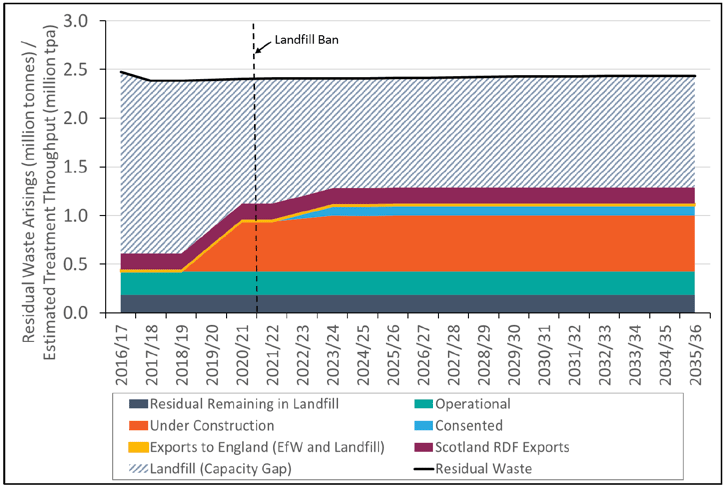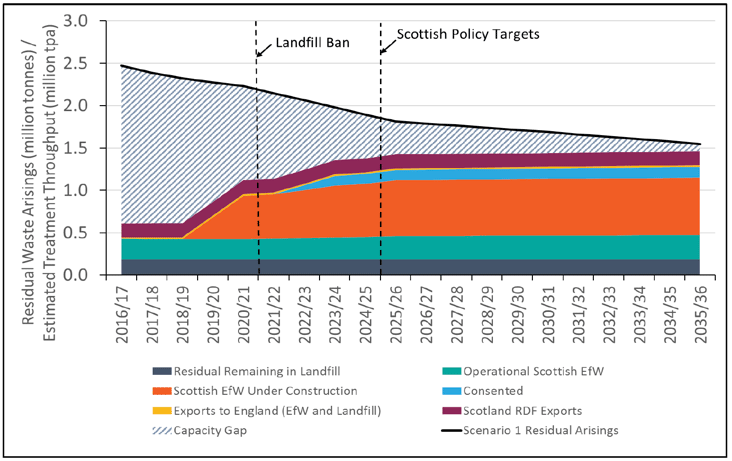Waste markets study: full report
Study regarding treatment options for Scottish biodegradable municipal waste.
Capacity Modelling
Capacity modelling was undertaken to understand the availability of treatment capacity to treat residual waste defined as waste affected by the landfill ban from 2021.
Methodology
Modelling Approach
To assess the longer-term trends in residual waste arisings and treatment capacity a time series model was developed with 2016/17 as the baseline year extending to 2035/36. The model firstly seeks to establish the total residual waste arisings affected by the ban. In parallel, we establish the treatment capacity that is already operational, under construction or has a high degree of certainty of reaching financial close. Comparing the two provides an understanding of the availability of treatment infrastructure to meet Scotland's needs (i.e. whether capacity outstrips demand or vice versa) over the short, medium and long term.
Modelling Total Residual Waste Arising
In order to understand the national picture in Scotland from 2016/17 to 2035/36, Eunomia's modelling approach started from an estimate of total waste generation in 2016/17 using the latest statistics published by SEPA:
- 2017 Scottish household waste data; and
- 2016 business waste data.
For this analysis, only household residual waste and the portion of commercial and industrial (C&I) waste streams likely to be affected by the ban were modelled. C&I waste streams, such as mining wastes and construction and demolition wastes, were excluded as they are unlikely to be affected. A relatively large tonnage of C&I waste is suitable for management by low-cost routes (e.g. direct land-spreading) or specialist facilities for managing industrial residues. This 'Other waste' was also excluded from the estimate of residual waste. The resulting estimate of residual waste is shown in Table 2. A full list of the C&I wastes assumed to be subject to the ban can be found in Appendix 4.
To establish the amount of residual waste likely to result, we deduct the proportion of waste that is likely to be recycled. For household waste, the starting point is the latest published recycling rates. Recycling rates were not available for business waste and therefore an assumption of 50% recycling has been applied to 2011 arisings, increasing incrementally to 55% by 2020. The resulting modelled recycling rates for 2017/18 are:
- 45.6% for household waste, and
- 53.8% for C&I waste.
- Assumptions regarding future recycling rates are discussed below.
Table 2: Total Waste Arising Assumptions 2016/17 (Millions of Tonnes)
| Waste Stream | Total Waste Generation (million tonnes) | Recycling Rate | Rate of Other Waste | Total Residual Waste (million tonnes) |
|---|---|---|---|---|
| Household Waste1 | 2.50 | 45.2% | N/A | 1.37 |
| Commercial Waste2 | 1.53 | 53.4% | 6.7% | 0.61 |
| Industrial Waste2 | 1.54 | 53.4% | 18.6% | 0.43 |
| Total | 5.58 | - | 2.41 |
Notes:
1 Scottish Household Waste – Summary Data 2017, Table 1: Scottish Household Waste Generated and Managed in 2017 – Summary Data.
2Scottish Business Waste Generated by Waste Type and Economic Sector 2016 (tonnes)
Modelling Treatment Capacity
Eunomia maintains a treatment facility database, which was used to establish the availability of treatment capacity in Scotland. The database includes facilities across the development lifecycle, but in order to focus on facilities that are likely to be available for use, the modelling was restricted to:
- operational facilities;
- capacity currently under construction; and
- facilities considered at or near financial close.
Facilities approaching financial close, but without a clear construction timetable yet in place, are assumed to come online in 2022/23. Analysis was based on data and information correct as of December 2018. Any treatment infrastructure reaching financial close since December 2018 is not reflected within this analysis.
The modelled throughput of operational thermal treatment facilities is based on their site return data. For facilities that are currently under construction or consented, the consented capacity is used as a starting point, but is modified by applying an average operational throughput based on the performance of operational facilities.
For gasification plants, an 80% efficiency rate has been assumed alongside a 95% availability of permitted capacity to account for facility downtime. For Mechanical Biological Treatment (MBT) facilities, an efficiency of 80% has been assumed, with facilities achieving a 33.7% mass reduction on their throughput. Table 3 summarises assumptions and Table 4 details the capacity for each Scottish facility.
Table 3: Treatment Capacity Assumptions
| Facility Type | Assumptions |
|---|---|
| Operational EfW | Site return data determines operational capacity |
| Under Construction and Consented EfW | Operational throughput of 73.7% of permitted capacity |
| Gasifier | 80% operational efficiency 95% availability of permitted capacity due to downtime |
| MBT | 80% operational efficiency 33.7% of throughput treated |
Table 4: Scottish Facility Capacity Assumptions
| Facility Name | Operator | Facility Type | Facility Capacity (Taking Account of Operational Efficiency) | Modelled Capacity (Taking Account of MBT Processing) | Status | Likely Yr Operational |
|---|---|---|---|---|---|---|
| Dundee Energy Recycling | Dundee Energy Recycling | Incineration | 84,669 | 84,669 | Operational | - |
| Shetland Heat Energy & Power | Gremista, Lerwick | Incineration | 22,965 | 22,965 | Operational | - |
| Renewii | Dumfries & Galloway | MBT | 49,400 | 16,648 | Operational | - |
| Renewii | Argyll & Bute | MBT | 30,780 | 10,373 | Operational | - |
| Western Isles Council | Western Isles | MBT | 15,960 | 5,379 | Operational | - |
| Levenseat | Levenseat Waste Management Site | MBT Gasifier |
304,000 45,600 |
102,448 | Operational | - |
| Viridor | Oxwellmains, Dunbar | Incineration | 221,166 | 221,166 | Under Construction | 2019 |
| Viridor | Polmadie | MBT/ Gasifier | 152,000 | 152,000 | Under Construction | 2019 |
| Shore Energy | Coatbridge | Gasification | 60,800 | 60,800 | Under Construction | 2022 |
| FCC Environment | Millerhill | Incineration | 140,072 | 140,072 | Under Construction | 2019 |
| Aberdeen / Aberdeenshire / Moray | East Tullos | Incineration | 106,897 | 106,897 | Consented | 2022 |
| TOTAL | - | - | - | 923,416 | - | - |
Based on information obtained from the Environment Agency (EA), the model assumes that 17,464 tonnes of Scottish residual waste was exported to England in 2016/17. Based on SEWEB data from 2016, it is also assumed that 164,000 tonnes of residual waste is currently exported to Europe as RDF (see Appendix 3 for further information).
Finally, as a cross-check, information provided by SEPA, based on landfill site returns for 2016/17, provides the basis for assuming that 2.05 million tonnes of waste is currently sent to landfill in Scotland and would be subject to the ban in 2021[2]. In addition, based on analysis undertaken by SEPA, it has been assumed that 25% of EWC code 19 12 12 'other waste from mechanical treatment' will be removed though additional sorting of fines and can therefore continue to be sent to Scottish landfill. This accounts for ~9% of total waste currently landfilled.
Modelling Recycling Rate Scenario
Two recycling scenarios have been modelled to understand how residual waste generation may change up to 2035. At higher recycling rates, less waste will require alternative treatment solutions after the ban.
Scenario 1: Recycling Policy Compliant Scenario
This scenario assumes the following policy goals are achieved:
- EU's recycling target of 50% by 2020, which applies to household waste UK-wide;
- Scottish recycling target for all waste of 70% by 2025. As there is no specific recycling target for municipal waste, the project steering group waste experts advised that a recycling rate of 60% should be assumed for both household waste and the municipal components of C&I waste by 2025;
- EU Circular Economy Package recycling target of 65% of municipal waste by 2035; and
- Scottish policy to reduce overall waste generation by 15% compared to 2011 arisings by 2025.
Recycling rates are assumed to increase incrementally, year on year, towards the next target.
It is assumed that changes in waste composition due to greater levels of recycling will lower the overall calorific value (CV) of residual waste. This is due to high energy producing material, such as plastics, being removed disproportionately when compared to lower CV materials like food waste or glass. As the CV decreases, more tonnes of waste can be processed in each EfW facility, since their capacity is limited by their thermal treatment capacity rather than by tonnage. The result of this assumption is to make available an additional 169,553 tonnes of capacity by 2035.
Scenario 2: Business as Usual Scenario
This scenario assumes that the Scottish recycling rates for both household and C&I waste remain at the 2017/18 rate through to 2035 (see Table 2). No reduction in overall waste arisings has been assumed; rather, a growth rate in line with national records of Scotland annual population growth rates for household arisings (0.43% between 2017 and 2018, falling to 0.11% between 2034 and 2035) and 0.5% per annum has been assumed for commercial waste, while a reduction in industrial waste of 1.0% per annum is assumed, reflecting the trend in this sector.
In both scenarios, it has been assumed that the background rate of RDF exports to mainland Europe remains at the 2016/17 level (164,000 tonnes), reflecting the extent to which Scottish councils and businesses are currently finding it convenient to enter into contracts for this service.
Results
Figure 3 shows the results of the capacity modelling for scenario 2. In this scenario, residual waste generation increases marginally up to a total of 2.40 million tonnes at the time when the ban comes into effect and 2.43 million tonnes by 2035. This leaves a capacity gap of 1.28 million tonnes at 1 January 2021, which decreases slightly as new facilities come on stream through to 2023/24 before growth in waste arisings increases it to 1.15 million tonnes by 2035.
Figure 4 shows the results of the capacity modelling for scenario 1. Residual waste generation is anticipated to decrease to 2.1 million tonnes per annum at the point at which the ban comes into effect in January 2021. The result is a shortfall of 1.01 million tonnes of treatment capacity compared with arisings. This capacity gap shrinks as Scotland moves towards its 60% recycling target, reaching 0.39 million tonnes per annum by 2025 and falling to 0.09 million tonnes per annum by 2035, when Scotland is assumed to meet the EU Circular Economy Package recycling target.
Figure 3: Scenario 1: Recycling Target - Capacity Modelling

Figure 4: Scenario 2: Business as Usual - Capacity Modelling

Contact
Email: eqce.cezw@gov.scot
There is a problem
Thanks for your feedback